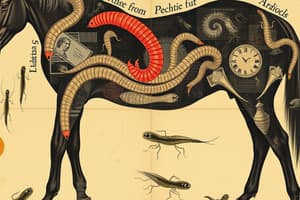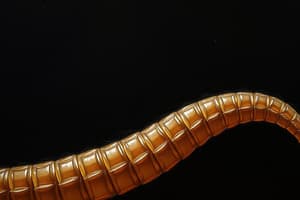Podcast
Questions and Answers
What happens when Taenia solium eggs are ingested by humans?
What happens when Taenia solium eggs are ingested by humans?
- They lead to taeniasis.
- They migrate to the lungs.
- They terminate in the small intestine.
- They cause cysticercosis. (correct)
Which organism serves as the definitive host for Taenia saginata?
Which organism serves as the definitive host for Taenia saginata?
- Cattle
- Humans (correct)
- Pigs
- Snails
What symptom is NOT associated with chronic schistosomiasis?
What symptom is NOT associated with chronic schistosomiasis?
- Abdominal pain
- Blood in urine
- Increased appetite (correct)
- Enlarged liver
How do Schistosoma larvae enter the human body?
How do Schistosoma larvae enter the human body?
What is the primary role of the scolex in Taenia solium?
What is the primary role of the scolex in Taenia solium?
What is the size range of adult schistosomes?
What is the size range of adult schistosomes?
Which organism is responsible for the transformation into fork-tailed larvae after invading snails?
Which organism is responsible for the transformation into fork-tailed larvae after invading snails?
What is a potential consequence of taeniasis caused by Taenia solium?
What is a potential consequence of taeniasis caused by Taenia solium?
Where does the female schistosome live?
Where does the female schistosome live?
What do cercariae do upon penetrating human skin?
What do cercariae do upon penetrating human skin?
What factor contributes to the high incidence of cysticercosis in low-income countries?
What factor contributes to the high incidence of cysticercosis in low-income countries?
How are schistosome eggs released into the environment?
How are schistosome eggs released into the environment?
What is the size of free-swimming cercariae?
What is the size of free-swimming cercariae?
What happens to schistosome eggs after they are laid?
What happens to schistosome eggs after they are laid?
What role does the sucker have for the male schistosome?
What role does the sucker have for the male schistosome?
What is the purpose of the free-swimming cercariae?
What is the purpose of the free-swimming cercariae?
What disease is caused by the blockage of lymphatics leading to edema and hydrocele?
What disease is caused by the blockage of lymphatics leading to edema and hydrocele?
Which organism is primarily responsible for lymphatic filariasis?
Which organism is primarily responsible for lymphatic filariasis?
What role do mosquitoes play in the life cycle of Wuchereria bancrofti?
What role do mosquitoes play in the life cycle of Wuchereria bancrofti?
What is a characteristic feature of infections in young individuals with filarial roundworms?
What is a characteristic feature of infections in young individuals with filarial roundworms?
Which of the following statements is true about the lifecycle of filarial roundworms?
Which of the following statements is true about the lifecycle of filarial roundworms?
Which parasitic infection is listed under neglected infections in the US and is caused by a protozoan?
Which parasitic infection is listed under neglected infections in the US and is caused by a protozoan?
What is the estimated global burden of neglected tropical diseases (NTDs) in terms of the number of affected individuals?
What is the estimated global burden of neglected tropical diseases (NTDs) in terms of the number of affected individuals?
Which of the following factors contributes to the selection of neglected parasitic infections as public health priorities?
Which of the following factors contributes to the selection of neglected parasitic infections as public health priorities?
What role do neglected tropical diseases play in impoverished communities?
What role do neglected tropical diseases play in impoverished communities?
Among helminths, which one has the highest estimated number of infections?
Among helminths, which one has the highest estimated number of infections?
What is the estimated annual death toll for malaria?
What is the estimated annual death toll for malaria?
Which of the following is true regarding the people most at risk for neglected parasitic infections?
Which of the following is true regarding the people most at risk for neglected parasitic infections?
What is the estimated cost per case for treating schistosomiasis?
What is the estimated cost per case for treating schistosomiasis?
What type of organisms do helminths belong to?
What type of organisms do helminths belong to?
Which of the following describes the term 'infection'?
Which of the following describes the term 'infection'?
What is the primary function of the scolex in tapeworms?
What is the primary function of the scolex in tapeworms?
How are infections caused by Ascaris primarily transmitted?
How are infections caused by Ascaris primarily transmitted?
Which phylum comprises flatworms like tapeworms?
Which phylum comprises flatworms like tapeworms?
What distinguishes infestation from infection in regards to helminths?
What distinguishes infestation from infection in regards to helminths?
Which of the following is NOT a characteristic of tapeworms?
Which of the following is NOT a characteristic of tapeworms?
What term is used for the final host in a host-parasite relationship?
What term is used for the final host in a host-parasite relationship?
Flashcards are hidden until you start studying
Study Notes
Helminths
- Multicellular animals, heterotrophic.
- Parasitic worms: microscopic.
- Highly adapted to parasitic lifestye: they survive by exploiting host resources.
- Obligate parasites: require a host to survive.
- Facultative parasites: can survive without a host.
- Estimated 3.8 billion infections worldwide.
Host Parasite Relationships
- Definitive host: the host where the parasite reproduces sexually.
- Intermediate host: the host where the parasite develops and matures.
- Some parasites require two hosts to complete their lifecycle.
- Only adult parasites reproduce.
Classification
- Phylum Platyhelminthes: Flattened in cross-section.
- Includes tapeworms and flukes
- Phylum Nematoda: Round in cross-section.
- Includes Ascaris, Enterobius, Trichinella, and Wuchereria.
Infestation vs. Infection
- Infection: Microbe multiplies in the host.
- Example: Bacterial or protozoan infections.
- Infestation: Invasion of the host by a parasite, but not reproduction.
- Example: Two worms can produce many eggs, but the host is only infested with those two worms.
Tapeworms
- Highly adapted to parasitism.
- Specialized structures:
- Scolex: for attachment to the host intestine.
- Proglottids: segments containing reproductive organs, produce many eggs.
- Hermaphroditic: Possess both male and female reproductive organs.
- No digestive system or significant musculature.
Taeniasis
- Human is the definitive host for Taenia solium (pig tapeworm) and T. saginata (beef tapeworm).
- Eggs or gravid proglottids are passed in human feces.
- Pigs and cattle ingest contaminated vegetation.
- Eggs hatch and migrate to striated (skeletal) muscle.
- Humans ingest larvae in undercooked meat.
- Worm attaches to the small intestine by the scolex.
- Up to 2000 proglottids, 100,000 eggs in each.
Cysticercosis
- Caused by ingestion of T. solium eggs.
- Larval cysts infect brain, muscles, and other tissues.
- A major cause of adult onset seizures in low-income countries.
Schistosomiasis
- Caused by the blood fluke Schistosoma.
- Eggs released in irrigated fields.
- Miracidia (ciliated larvae) invade snails.
- Cercariae (fork-tailed larvae) are released from snails.
- Cercariae penetrate human skin and mature in blood vessels.
- Eggs are then voided in feces or urine.
Symptoms of Schistosomiasis
- Abdominal pain
- Enlarged liver
- Blood in stool or urine
- Problems passing urine
- Increased risk of bladder cancer.
Filarial Roundworms
- Lymphatic filariasis (elephantiasis): chronic deforming disease.
- Increases risk of bacterial infections.
- Wuchereria bancrofti: mosquito vector.
- Mosquito picks up microfilariae from a diseased host.
- Parasites develop into infective larvae in the mosquito.
- Larvae are transmitted to a new host during a blood meal.
- Worms mature in lymphatic vessels and reproduce.
- Blockage of lymphatics causes edema of lower extremities.
Other Important Roundworm Parasites
- Guinea Worm: Ingestion of copepods in water.
- Eye Worm (Loa Loa): Biting black fly vector.
- Heartworms (canine filariasis): Mosquito vector.
- Onchocerca (River Blindness): Black fly vector.
Neglected Parasitic Infections in the US
- CDC has identified five parasitic diseases as priorities for public health action:
- Chagas Disease
- Cysticercosis
- Toxocariasis
- Toxoplasmosis
- Trichomoniasis
Neglected Tropical Diseases
- A group of parasitic and bacterial diseases affecting over one billion people globally.
- Affect the world's poorest people, impairing physical and cognitive development.
- Contribute to poverty and disease cycles.
Human Impact of Parasites
- Estimated 4.46 billion infections from all helminths.
- Significant deaths per year from parasitic diseases.
- Example: Schistosomiasis causes 20 million deaths per year.
Misery Compounding Itself
- Prevalence of neglected tropical diseases in impoverished areas, leading to cycles of poverty and disease.
- People who survive infectious diseases may still be vulnerable to starvation due to malnutrition.
- Access to cures for neglected tropical diseases is crucial.
Studying That Suits You
Use AI to generate personalized quizzes and flashcards to suit your learning preferences.




